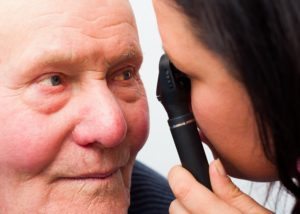Four Age-related Vision Problems in Seniors

Senior Care in Scarsdale NY: Four Age-related Vision Problems in Seniors
As eyes age, there are several common diseases that can ultimately affect your parent’s eyesight. Early detection is the key to keeping damage to a minimum and your loved one’s vision strong. Once the damage is done it is often irreversible. Loss of vision in the elderly can lead to increased dependency with loss of mobility and an increased susceptibility to falls. According to an article in the American Family Physician, “Approximately one person in three has some form of vision-reducing eye disease by the age of 65.”
Glaucoma
Glaucoma is the second-leading cause of blindness in America. In most cases, it is caused by an increase in intraocular pressure—the fluid pressure inside the eye. When this pressure builds up, it damages the optic nerve which ultimately results in loss of vision. Peripheral vision is the first to go and is often the only sign of glaucoma. Once the damage is done, it cannot be reversed.
Age-related Macular Degeneration
Age-related macular degeneration is the leading cause of blindness in people over 65 years of age in the U.S. It is caused by degeneration of the central portion of the retina known as the macula. It produces loss of central vision. The early stages often produce no symptoms, but as it develops your parent may complain about difficulty watching TV or reading, and increasing difficulty walking from a well-lit room into the dark. Impaired depth perception can increase the chances of a fall.
Cataracts
Cataracts are cloudy areas in the lens of the eye caused by protein that clumps together. Over half of the population in America that is over the age of 80 have cataracts or had them at some point in their lives. The good news is that this is one disease process that results in vision loss that can be improved by surgery. The first symptom is cloudy or blurred vision that is not benefitted from glasses.
Diabetic Retinopathy
This complication of diabetes is caused by damage to the small capillaries of the retina. No symptoms may be apparent in the initial stages in this disease that can ultimately lead to blindness. Floaters and blurred vision may be the earliest signs.
Risk Factors
Many of these eye diseases have the same associated risk factors. These include smoking, high blood pressure, and diabetes.
Caring for Seniors
Because many of these eye disorders show no initial symptoms, it’s important that your parent see their ophthalmologist at least once a year for a comprehensive eye exam. In addition, eating a healthy diet that incorporates a wealth of fruits and vegetables as well as scheduling at least 30 minutes of exercise a day helps support a healthy body and eyes.
Senior Care Provider
If your loved one requires assistance with the daily activities of living due to vision loss, consider obtaining the services of a senior care provider. In addition to performing daily tasks, they can prepare eye-healthy meals and accompany your parent on daily walks, helping them achieve a healthy, balanced life.
If you or an aging loved one are looking for senior care in Scarsdale, NY, call the friendly staff at The Perfect Home Care at (855) 855-5728. Call today!
Resources
http://www.aafp.org/afp/1999/0701/p99.html
https://nei.nih.gov/health/cataract/cataract_facts
- How Can You Tell When Your Elderly Loved One Really Can’t Live on Her Own Any Longer? - May 12, 2017
- Four Age-related Vision Problems in Seniors - April 14, 2017
- 5 Things to Know About Occupational Therapy - April 7, 2017




